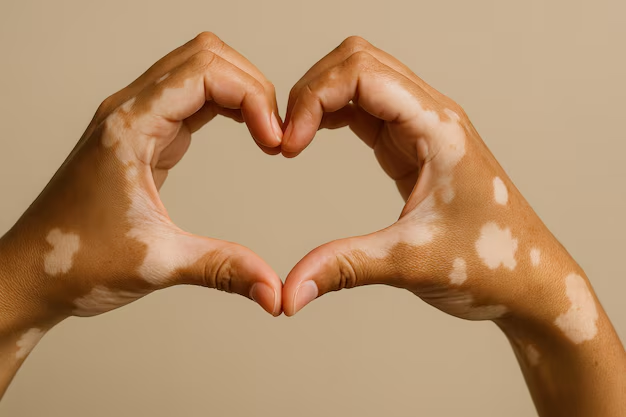Discovering the Mystery: Why Does My Vitiligo Appear in Blotches?
For those living with vitiligo, the skin condition that causes loss of pigmentation, seeing your skin changing and losing its color patch by patch can be strange and unsettling. If you've found yourself wondering, "Why is my vitiligo in blotches?" you're not alone, and understanding this condition is the first step to feeling more in control of your own skin story.
What Exactly is Vitiligo?
Vitiligo is a chronic skin condition where the immune system mistakenly attacks the melanocytes, the cells responsible for producing melanin, the pigment that gives your skin its natural color. This autoimmune action results in white patches appearing on the skin, which can vary significantly in size and location.
Common Patterns in Vitiligo
The reason you notice blotches or patches with vitiligo comes down to the nature of how this condition progresses:
Segmental Vitiligo: This type generally appears in a localized, unilateral pattern often affecting areas like the face, a limb, or scalp.
Non-Segmental Vitiligo: More common than segmental, it often appears symmetrically on both sides of the body. This type can spread over time, covering larger skin areas.
Understanding these patterns helps explain why the vitiligo patches or blotches often appear seemingly random yet follow certain tendencies.
The Science Behind the Blotches
Random vs. Patterned Pigment Loss
While the loss of pigment may seem random, there is a method behind the "madness." Vitiligo doesn't choose the skin areas it affects at random. Instead, the immune response may be triggered by several factors, including:
- Genetic Predisposition: Family history can play a significant role.
- Environmental Triggers: Stress, chemical exposure, or even a sunburn can activate vitiligo.
- Autoimmune Factors: Often, those with vitiligo may have other autoimmune disorders.
How Blotches Develop
The formation and characteristics of these blotches often depend on:
- The rate of melanin destruction—some patches can appear suddenly while others may develop slowly over time.
- The regenerative ability of melanocytes in the surrounding skin areas.
- The immune system’s targeting behavior, which might focus on specific areas more than others.
Skin Differences and Reactions
The Role of Skin Thickness and Type
Your skin varies in thickness and type across your body, influencing vitiligo's appearance:
- Thinner Skin Areas: Such as around the eyes and mouth, might show more pronounced blotches due to the density of melanocytes.
- Skin Creases and Folds: Places like elbows, knees, and other joints frequently display more noticeable pigmentation loss because they experience more friction and environmental contact.
Emotional Impact of Vitiligo
Navigating the Emotional Journey
Coping with vitiligo isn't just about managing skin appearance but acknowledging the psychological journey that comes with it.
- Initial Shock and Adjustment: Discovering patches can be alarming. Acceptance is a process that happens over time.
- Societal Perceptions and Self-Image: Living with visible differences can affect one’s self-esteem. Walking through this requires strength and sometimes, seeking community support or counseling.
- Empowerment Through Knowledge: Educating oneself about vitiligo is empowering, enhancing personal agency over one’s health journey.
Practical Tips to Manage Vitiligo
Being Skin-Friendly
While vitiligo management primarily focuses on cosmetic adjustments or medical therapies suggested by healthcare providers, some skin-care tips can support those with vitiligo:
- Sun Protection: Always wear a high SPF sunscreen. Unprotected skin, especially areas with vitiligo, is more vulnerable to UV damage.
- Hydration: Moisturize regularly to maintain skin health.
- Reduce Triggers: Identify environmental or lifestyle triggers that may exacerbate condition progression.
Dressing with Confidence
Choosing the right fabric and apparel can also be a part of managing comfort and confidence:
- Comfortable Clothing: Natural fibers like cotton can be more soothing on sensitive skin.
- Creative Expression: Use clothing and accessories to express personal style and draw attention to features beyond the skin.
Support and Community
Finding Your Tribe
Living with a visible difference can be isolating, but numerous communities bring people with vitiligo together.
- Online Forums and Support Groups: Connecting with others offres shared experiences and tips.
- Personal Advocacy: Engage in advocacy or public speaking to empower others and yourself.
Staying Informed
Keeping up with the latest in skin science can be empowering:
- Research Developments: Stay informed about advances in treatments and management strategies.
- Continued Learning: Engage in workshops or informational sessions that discuss the wider implications and management of vitiligo.
Bridging Science and Personal Experience
Understanding why your vitiligo appears the way it does involves appreciating both the scientific explanations and personal narratives. Each individual’s journey with vitiligo is unique, leading to diverse experiences and coping strategies.
Ultimately, embracing the individuality of your skin story can be both a challenge and an opportunity. By combining scientific understanding with self-compassion, you can navigate your path with strength and resilience.
Visual Summary
- 🌟 Embrace Your Unique Pattern: Understanding why vitiligo appears in patches can foster self-acceptance.
- 🧬 Know the Science: Vitiligo is an autoimmune condition where the immune system attacks pigment-producing cells.
- 🛡️ Protect Your Skin: Sun protection is critical. Moisturizers help to keep the skin healthy.
- 🤝 Join a Community: Find support groups to share experiences and gain support.
- 📚 Stay Informed: Keep up with research for potential new treatments.
- 👗 Dress Confidently: Use fashion as a form of personal expression.
Finding beauty beyond the pigment, celebrating each unique patch, and supporting holistic health remain keys to living empowered with vitiligo.
